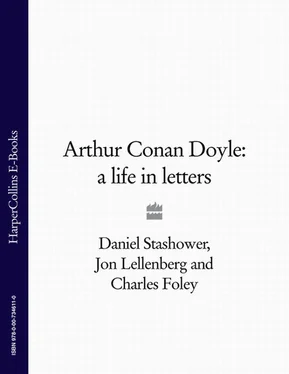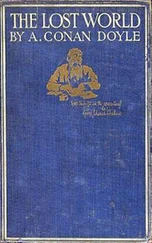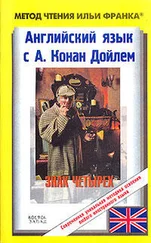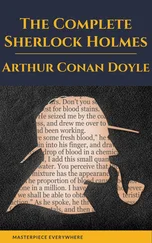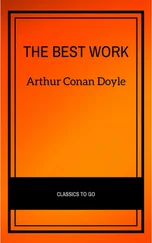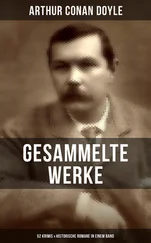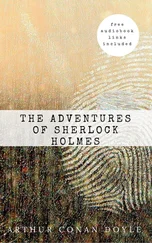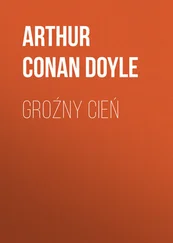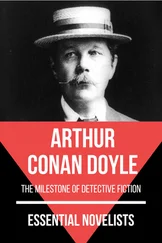Conan Doyle admired his mother greatly, and she was his principal confidant his entire life. He went away to boarding school at the age of eight in 1867 (a year earlier than previously believed), starting the flow of letters that lasted until her death at the end of 1920, fifty-four years later. Roughly a thousand have survived, touching on nearly everything going on in his life, and letting us into his mind. They were among papers of his that were locked away for over fifty years because of family disagreements. They finally came to his youngest child, Dame Jean Conan Doyle, not long before her death in 1997, and were bequeathed by her to the British Library. Complementing them here are other letters to his father, his brother and sisters, and other figures in his life, which we have arranged and annotated to provide his life in letters. The correspondence constitutes a far more candid autobiography than the one that Conan Doyle actually published in the 1920s—called Memories and Adventures —which was long on adventures but deliberately short on the memories.
Virtually no aspect of Conan Doyle’s life and work goes unmentioned in these letters, and they depict his personality and life far more completely and candidly than any previous treatment. They also contain many discoveries that greatly extend and often contradict the existing knowledge of his life. Other members of his family come into sharper focus as well, including his father. Charles Doyle has been accused on little if any evidence of being a volatile, even violent figure in the home, but there is no sign of that in the many references here, only regret over the infirmities that blighted his life and strained the family’s resources. Other discoveries have led to previously unknown Conan Doyle work—including the only known example of his advertising copywriting, in verse, and a talk before four hundred physicians and the Prince of Wales that he called the most successful he’d ever given.
Gracefully written and consistently revealing, Arthur Conan Doyle’s letters illuminate every phase of his life, tracing his development from a schoolboy through his years as a fledgling story writer, then to the years of his immense success as a writer, becoming one of the most popular and influential voices of his time. He was a man of his era, and occasionally prone to its prejudices, though perhaps less than one might expect in the private correspondence of a man born in 1859. And occasionally he had a temper as well. We have left intact examples of these, and of what some today would call his politically incorrect views on various subjects. When Sidney Paget, the artist who illustrated Sherlock Holmes for the Strand magazine, came to paint Conan Doyle’s portrait in 1899, the author insisted upon being depicted ‘warts and all’. This is likewise a warts and all portrait, as he would not have approved of being presented as other than he was.
His mother’s influence is evident in every aspect of her son’s character. ‘The Mam’, as he called her, *raised seven children in Victorian Edinburgh (two more died in infancy or childhood) in what were certainly straitened if not absolutely Dickensian circumstances. In later years Conan Doyle said his childhood had been spent in ‘the hardy and bracing atmosphere of poverty’, but that was a rather sunny way of looking at it, even though it appears to have been a genteel sort of poverty, usually with at least one servant in the household.
But Charles Doyle’s alcoholism led to his being pensioned off when still in his forties, deepening the family’s plight; and when he entered the first of a long series of sanatoria and asylums, it was his wife, Mary, who struggled successfully to hold the large family together. Throughout his life Conan Doyle felt a powerful debt to her, and a keen awareness of the many sacrifices she made to secure his education and his start in life. In his 1895 autobiographical novel, entitled The Stark Munro Letters, Conan Doyle gave an admiring portrait of his mother:
You must remember her sweet face, her sensitive mouth, her peering, short-sighted eyes, her general suggestion of a plump little hen, who is still on the alert about her chickens.
But you cannot realise all that she is to me in our domestic life. Those helpful fingers! That sympathetic brain! Ever since I can remember her she has been the quaintest mixture of the housewife and the woman of letters, with the high-bred spirited lady as a basis for either character. Always a lady, whether bargaining with the butcher, or breaking in a skittish charwoman, or stirring the porridge, which I can see her doing with the porridge-stick in one hand, and the other holding her Revue des Deux Mondes within two inches of her dear nose. That was always her favourite reading, and I can never think of her without the association of its browny-yellow cover.
She is a very well-read woman is the mother; she keeps up to date in French literature as well as in English, and can talk by the hour about the Goncourts, and Flaubert, and Gautier. Yet she is always hard at work; and how she imbibes all her knowledge is a mystery. She reads when she knits, she reads when she scrubs, she even reads when she feeds her babies. We have a little joke against her, that at an interesting passage she deposited a spoonful of rusk and milk into my little sister’s ear-hole, the child having turned her head at the critical instant. Her hands are worn with work, and yet where is the idle woman who has read as much?
Even at the peak of his fame, Conan Doyle solicited his mother’s advice on nearly every aspect of his life and career—and even when he did not, she often provided it anyway—including, in one famous example, persuading him to refrain from killing off Sherlock Holmes. (She not only pleaded successfully for the detective’s life, but also gave her son the plot device for a new story. ‘He still lives,’ Conan Doyle told her at the end of the first set of the stories, ‘thanks to your entreaties.’) But not all her advice was literary; she also counselled him on his tortuous love for the young woman who would become his second wife, while his first wife was still struggling against tuberculosis. While he did not preserve many of her letters to him, he did save the ones in which she strove vehemently to dissuade him from volunteering for the Boer War in 1899. In those letters her will and intellect shine every bit as forcefully as those of her famous son.
In addition, there were several more women in Conan Doyle’s life whom he regarded as ‘second mothers’, addressing them, as he did his own, by the honorific ‘Mam’. They did not exert the same developmental influence upon him as his own mother did, but he clearly regarded them with an esteem that went beyond simple family friendship. There was Mrs Charlotte Drummond, a close family friend in Edinburgh with whose two children Conan Doyle had grown up. His letters to her are in the Sherlock Holmes Collections of the University of Minnesota Library. Another was Mrs Amy Hoare, the wife of a Birmingham doctor, Reginald Ratcliff Hoare, under whom Conan Doyle worked a number of times as both a medical student and a fledgling doctor. Both Hoares became second parents to him, and his letters to them are in the Henry W. and Albert A. Berg Collection of English and American Literature at the New York Public Library. Finally, there was Mrs Margaret Ryan, of Edinburgh, the mother of the one lifelong friend he made at school, James Ryan. Some of his letters to her are among his papers now at the British Library.
Conan Doyle was part of a very large family, and it is no simple matter to keep all of its members straight as the reader moves through his letters. *His grandfather John Doyle, the London political cartoonist known as ‘H.B.’, was born in April 1797, and died on January 2, 1868, when Conan Doyle was eight years old. He had some memory of his grandfather, but not of his paternal grandmother, Marianne Conan, who had died at the end of 1839. Her brother, Michael Conan, a journalist who lived in Paris much of his life, was godfather to Arthur and his older sister Annette, with his surname being added to theirs at the baptismal font to form the compound name Conan Doyle. This name was not held by their parents’ subsequent children.
Читать дальше
